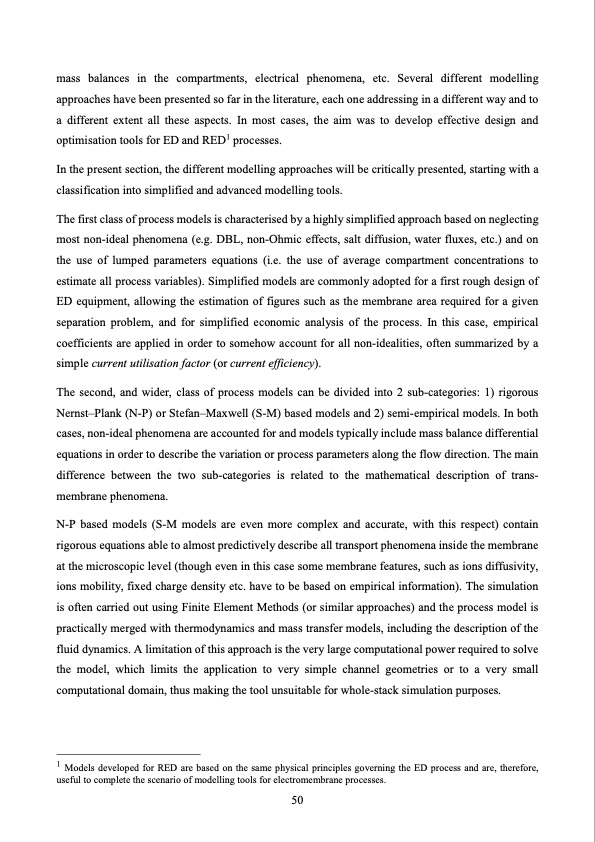
PDF Publication Title:
Text from PDF Page: 050
mass balances in the compartments, electrical phenomena, etc. Several different modelling approaches have been presented so far in the literature, each one addressing in a different way and to a different extent all these aspects. In most cases, the aim was to develop effective design and optimisation tools for ED and RED1 processes. In the present section, the different modelling approaches will be critically presented, starting with a classification into simplified and advanced modelling tools. The first class of process models is characterised by a highly simplified approach based on neglecting most non-ideal phenomena (e.g. DBL, non-Ohmic effects, salt diffusion, water fluxes, etc.) and on the use of lumped parameters equations (i.e. the use of average compartment concentrations to estimate all process variables). Simplified models are commonly adopted for a first rough design of ED equipment, allowing the estimation of figures such as the membrane area required for a given separation problem, and for simplified economic analysis of the process. In this case, empirical coefficients are applied in order to somehow account for all non-idealities, often summarized by a simple current utilisation factor (or current efficiency). The second, and wider, class of process models can be divided into 2 sub-categories: 1) rigorous Nernst–Plank (N-P) or Stefan–Maxwell (S-M) based models and 2) semi-empirical models. In both cases, non-ideal phenomena are accounted for and models typically include mass balance differential equations in order to describe the variation or process parameters along the flow direction. The main difference between the two sub-categories is related to the mathematical description of trans- membrane phenomena. N-P based models (S-M models are even more complex and accurate, with this respect) contain rigorous equations able to almost predictively describe all transport phenomena inside the membrane at the microscopic level (though even in this case some membrane features, such as ions diffusivity, ions mobility, fixed charge density etc. have to be based on empirical information). The simulation is often carried out using Finite Element Methods (or similar approaches) and the process model is practically merged with thermodynamics and mass transfer models, including the description of the fluid dynamics. A limitation of this approach is the very large computational power required to solve the model, which limits the application to very simple channel geometries or to a very small computational domain, thus making the tool unsuitable for whole-stack simulation purposes. 1 Models developed for RED are based on the same physical principles governing the ED process and are, therefore, useful to complete the scenario of modelling tools for electromembrane processes. 50PDF Image | Electrodialysis for water desalination

PDF Search Title:
Electrodialysis for water desalinationOriginal File Name Searched:
Review_ED-self-archived.pdfDIY PDF Search: Google It | Yahoo | Bing
NFT (Non Fungible Token): Buy our tech, design, development or system NFT and become part of our tech NFT network... More Info
IT XR Project Redstone NFT Available for Sale: NFT for high tech turbine design with one part 3D printed counter-rotating energy turbine. Be part of the future with this NFT. Can be bought and sold but only one design NFT exists. Royalties go to the developer (Infinity) to keep enhancing design and applications... More Info
Infinity Turbine IT XR Project Redstone Design: NFT for sale... NFT for high tech turbine design with one part 3D printed counter-rotating energy turbine. Includes all rights to this turbine design, including license for Fluid Handling Block I and II for the turbine assembly and housing. The NFT includes the blueprints (cad/cam), revenue streams, and all future development of the IT XR Project Redstone... More Info
Infinity Turbine ROT Radial Outflow Turbine 24 Design and Worldwide Rights: NFT for sale... NFT for the ROT 24 energy turbine. Be part of the future with this NFT. This design can be bought and sold but only one design NFT exists. You may manufacture the unit, or get the revenues from its sale from Infinity Turbine. Royalties go to the developer (Infinity) to keep enhancing design and applications... More Info
Infinity Supercritical CO2 10 Liter Extractor Design and Worldwide Rights: The Infinity Supercritical 10L CO2 extractor is for botanical oil extraction, which is rich in terpenes and can produce shelf ready full spectrum oil. With over 5 years of development, this industry leader mature extractor machine has been sold since 2015 and is part of many profitable businesses. The process can also be used for electrowinning, e-waste recycling, and lithium battery recycling, gold mining electronic wastes, precious metals. CO2 can also be used in a reverse fuel cell with nafion to make a gas-to-liquids fuel, such as methanol, ethanol and butanol or ethylene. Supercritical CO2 has also been used for treating nafion to make it more effective catalyst. This NFT is for the purchase of worldwide rights which includes the design. More Info
NFT (Non Fungible Token): Buy our tech, design, development or system NFT and become part of our tech NFT network... More Info
Infinity Turbine Products: Special for this month, any plans are $10,000 for complete Cad/Cam blueprints. License is for one build. Try before you buy a production license. May pay by Bitcoin or other Crypto. Products Page... More Info
| CONTACT TEL: 608-238-6001 Email: greg@infinityturbine.com | RSS | AMP |